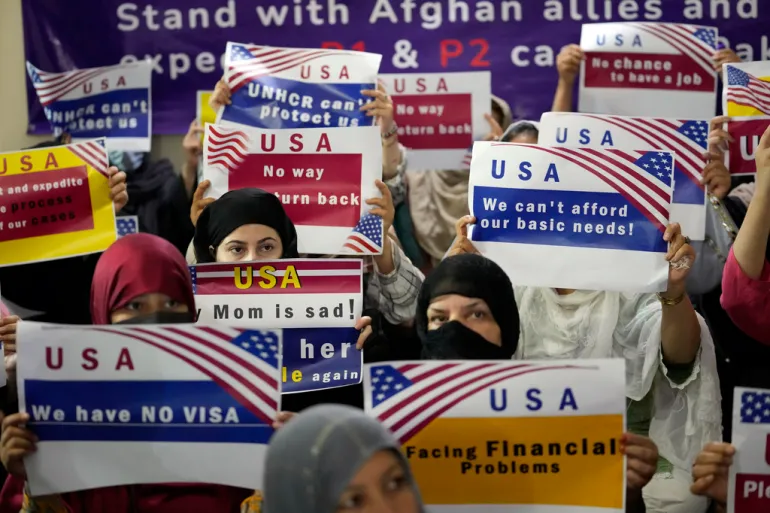The trump administration refugee suspension admissions was one of its most debated policies, drawing both criticism and support. This initiative was part of broader immigration measures aimed at fortifying national security. Below, we’ll explore what the refugee suspension entailed, its objectives, implications, and long-term outcomes.
What Was the Trump Administration Refugee Suspension?
The refugee suspension under the Trump administration officially began with Executive Order 13769, often referred to as the “travel ban” or “Muslim ban.” Introduced in January 2017, it initially restricted entry from seven predominantly Muslim countries and temporarily halted the U.S. Refugee Admissions Program (USRAP) for 120 days. Syrian refugees were banned indefinitely until further review.
However, this policy evolved after legal challenges, with subsequent versions scaling back and refining its scope. The stated purpose of the suspension was to allow a comprehensive review of security vetting processes for incoming refugees.
Key Features of the Suspension:
- Triggered by Executive Order 13769:
-
- Aimed at improving vetting procedures for refugees and travelers.
- Included countries like Iran, Iraq, Syria, Libya, Sudan, Yemen, and Somalia.
- 120-Day Pause on Refugee Admissions:
-
- Intended to review and tighten security protocols.
- Reduction in Refugee Cap:
-
- The annual refugee admissions ceiling was significantly reduced from 110,000 (under the Obama administration) to 50,000 in 2017.
For more details on technology and its role in security advancements, explore Turbotechify’s latest insights.
The Motivation Behind the Refugee Suspension
The Trump administration cited national security as the principal justification for the refugee suspension. Officials argued that the vetting systems in place at the time were insufficient to prevent potential threats posed by refugees from high-risk regions.
Core Objectives:
- Strengthening National Security:
-
- Aimed to mitigate risks of terrorism associated with inadequate background checks.
- Improving Screening Measures:
-
- Focused on ensuring that admitted refugees posed no security risks.
- Aligning with America First Agenda:
-
- Advocated prioritizing domestic concerns over international commitments.
Critics, however, contended that the suspension disproportionately targeted Muslim-majority countries, breeding racial and religious discrimination.
Immediate Impacts of the Policy
The refugee suspension had far-reaching implications, both domestically and internationally.
On Refugees:
- Reduced Admissions:
-
- Only 33,000 refugees were resettled in 2017, a dramatic decrease from previous years.
- Prolonged Waiting Periods:
-
- Refugees seeking resettlement faced significant delays due to additional background checks.
- Uncertainty for Families:
-
- Many families were left separated, with no clear timeline for reunification.
On the U.S. Economy:
- Labor Gaps:
-
- Refugees often fill labor shortages in industries like agriculture and healthcare. Fewer arrivals exacerbated workforce challenges in these sectors.
- Reduced Consumer Spending:
-
- Refugee communities contribute to local economies through consumption and business ventures, which diminished due to lower admissions.
On Global Relations:
- Strained Alliances:
-
- The policy drew criticism from international allies and humanitarian organizations.
- Setbacks for Vulnerable Populations:
-
- Global refugee resettlement efforts faced a bottleneck, forcing other countries to bear more responsibility.
Long-Term Policy Impacts
The refugee suspension and subsequent restrictions laid the groundwork for a larger ideological shift in U.S. immigration policy.
Refugee Admissions Cap
One of the most notable outcomes was the consistent reduction in the refugee admissions ceiling. Between 2017 and 2020, the cap went from 110,000 to a historic low of 15,000. This shift reshaped the U.S.’s role as a global leader in refugee resettlement.
Here’s a breakdown of the refugee cap during the Trump administration:
|
Year |
Refugee Admissions Cap |
Actual Admissions |
|---|---|---|
|
2016 (pre-Trump) |
110,000 | 84,994 |
| 2017 | 50,000 | 33,000 |
| 2018 | 45,000 | 22,500 |
| 2019 | 30,000 | 22,900 |
| 2020 | 18,000 | 11,814 |
Overhauls in Vetting
Security protocols underwent significant changes, including the implementation of enhanced biometric screenings, social media vetting, and more stringent background checks.
These measures aimed to make the U.S. refugee program more secure, though critics argued they introduced unnecessary hurdles for vulnerable populations.
Public Opinion
The refugee suspension polarized public opinion. For some Americans, the policy symbolized decisive action to protect the nation from potential security risks. However, others viewed it as an act of xenophobia, undermining the country’s history as a safe haven for the persecuted.
Criticism and Legal Challenges
The refugee suspension faced numerous legal and ethical challenges. Civil rights organizations argued the policy violated the U.S. Constitution by targeting individuals based on religion.
Notable Legal Developments:
- Federal Court Rulings:
-
- Multiple courts initially blocked the implementation of Executive Order 13769, deeming it unconstitutional.
- Supreme Court Decision:
-
- Eventually, a revised version of the order was upheld by the Supreme Court in June 2018.
Ethical Concerns:
- Refugee advocates pointed out the moral responsibility of the U.S. to assist displaced populations.
- Faith-based organizations, including Christian groups, resisted the suspension, emphasizing the importance of humanitarian aid.
Comparing Present and Past Refugee Policies
Under the Biden administration, efforts began to reverse some of the refugee restrictions. The annual refugee cap for 2023 was restored to 125,000, marking a shift back toward pre-Trump levels.
Here’s a side-by-side comparison of key policy shifts:
|
Policy Element |
Trump Administration |
Biden Administration |
|---|---|---|
|
Refugee Cap |
Reduced to a historic low of 15,000 |
Increased to 125,000 |
|
Vetting Requirements |
Enhanced, with biometric and social media checks |
Maintained enhanced vetting, but streamlined processes |
|
Focus on Priority |
Humanitarian responsibility |
While the Biden administration has taken steps to rebuild the refugee program, challenges persist as years of restrictive policies have created backlogs and resource shortages.
The Role of Technology in Refugee Processing
Technology played a crucial role in enabling the enhanced vetting systems introduced during the Trump administration. From biometric data collection to AI-based screening tools, these innovations have reshaped how refugees are processed.
To learn how tech trends like AI and blockchain continue to shape refugee programs, check out our insights at Turbotechify.
Closing Thoughts
The Trump administration’s refugee suspension was a defining policy in American immigration history. For supporters, it represented a necessary measure to protect national security. For critics, it stood as a symbol of exclusionary politics.
Regardless of one’s perspective, the policy’s legacy underscores the delicate balance between national security and humanitarian obligations. The evolution of this issue offers valuable lessons in navigating future immigration challenges while upholding American ideals of compassion and justice.
For additional resources on technology’s impact on policy implementation, visit Turbotechify.


